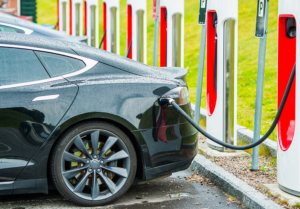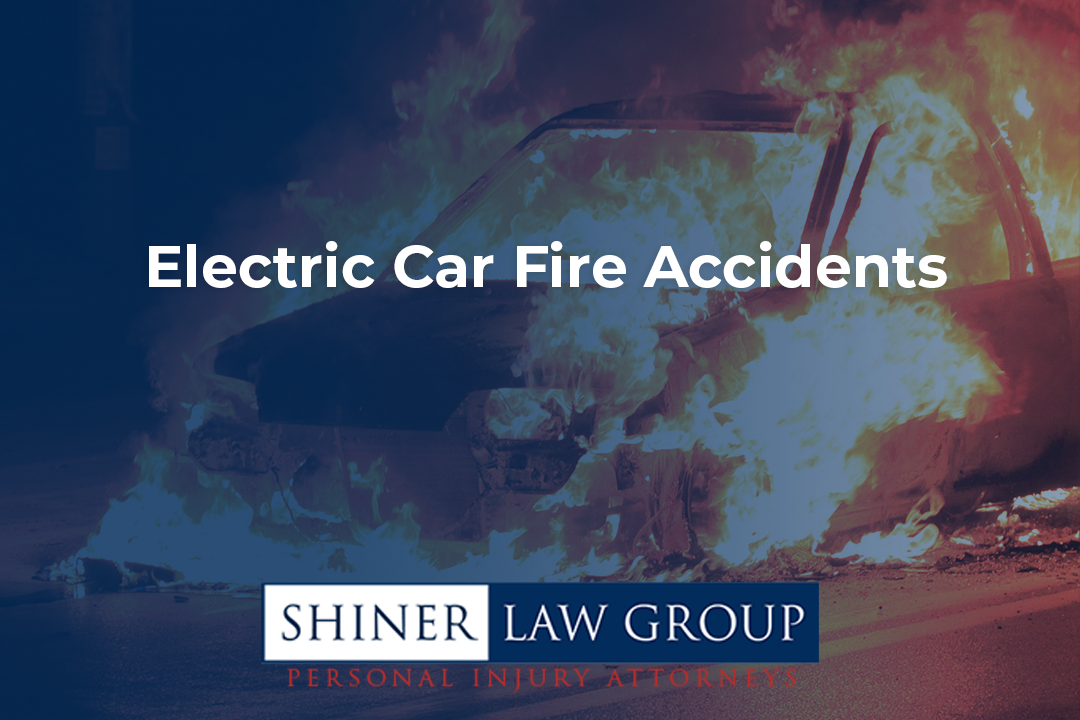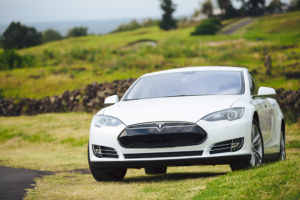
A vehicle fire is a terrifying prospect if you happen to be in the vehicle at the time a fire starts. With the windows closed, even with the climate control on, a fire will quickly consume all the oxygen in the vehicle, incapacitating you long before it’s all gone. There are just a couple of things you can do to prepare for such an occurrence.
Electric Car Fire Risk
First, you can keep an escape tool in an easily accessible place in your vehicle. An escape tool is a specially shaped club designed to shatter a car’s window quickly and easily. Usually, one swipe is all that’s necessary to smash the window. Not only will this ensure that you won’t suffocate, but it will also give you an escape route if you cannot open the door for any reason. In late-model vehicles, however, manufacturers are using laminated glass instead of tempered glass. Even with an escape tool, breaking the laminated glass is impossible. Many vehicles have one window that is tempered, though, so it pays to check your manual to know which one it is.
Second, you should have a small fire extinguisher in the car as well. Even a small one can extinguish flames of many sizes, and even if it doesn’t extinguish the fire, it can reduce it enough to make an escape from the burning car easier.
Electric cars, even though they don’t use fuel, can experience fires, too, so these two steps are great safety measures if you own an electric car.
How Common Are Electric Car Fires?
Electric car fires are exceedingly rare. There will be only three electric car fires per 1,000 vehicles over the vehicle’s lifetime. Fuel-powered vehicles will experience fires 35 times more frequently over their lifetimes.
Since 2010, researchers who study vehicle fires found 200 fires in electric cars over the last 12 years. That research also studied the whole world and not just the United States. The U.S., however, had the most fires of that, 200: 52. The researchers also stated that in 20 years, the percentage of electric cars that experience fires might go up after two decades of wear and tear.
The number of fires has stayed constant since electric vehicles jumped from experimental status to a viable choice for people buying vehicles.
Are Electric Cars More Prone to Fires?
Electric cars are not more prone to catching fire than their fuel-powered counterparts. Hybrid vehicles often catch fire because they, in essence, have two engines. It’s still not common even when considering hybrid vehicles, which catch fire about 130 times for every straight-up electric car. That’s still only roughly 3,000 per 100,000 or one in a hundred vehicles over the vehicle’s life.
A new lithium battery is also even less prone to fires than lithium-ion batteries. It’s called the lithium iron phosphate battery. Recently, Tesla, Volkswagen, and Ford are switching to these new batteries for their newest vehicles. This will make a rare event even rarer. Still, the risk is so low that there are no plans to recall and retrofit already-produced electric vehicles. The same holds true for hybrid cars, whose fire incidence will also be drastically reduced.
Improvements are “coming down the pike” more and more quickly these days, so changes to the power plants of electric vehicles are inevitable. As the market changes, safety measures for these electric vehicles are bound to change along with it.
What Causes Electric Car Fires?

Electric vehicles don’t have fuel in the traditional sense. The vast majority of them do have lithium-ion batteries that relatively pack a lot of power into a very small space. Batteries of all kinds create power through a chemical reaction that causes electrons to flow from one place to another. Sometimes, that’s in liquid form, and sometimes it’s not.
In lithium ion batteries, the transfer of electrons is from the anode, which is usually solid graphite, to the liquid lithium manganese oxide cathode through an electrolyte. The electrons travel with lithium ions, hence the name of the battery.
Energy can neither be created nor destroyed, only converted from one form to another. So, during the lithium-ion battery creates electricity, the reaction produces waste heat. It’s the same process as the battery powering your cell phone, only on a larger scale. That’s why batteries get hot when you use them a lot.
The fire danger comes from an event called “thermal runaway.” It’s when the electricity-producing reaction reaches a critical point and becomes self-perpetuating. Sometimes, it’s relatively mild, but other times it can be dangerously violent. The batteries can explode, ejecting superheated gas and solid pieces of the battery. The battery could also smoke, smolder, and catch fire in the extreme heat.
The most common cause of thermal runaway is an internal short circuit in the battery itself. Even in the most advanced battery technology, the same old issues cause problems. Aside from short circuits, overcharging, excessively high and low charges in quick succession, and temperature extremes are all reasons for thermal runaway.
Which Electric Cars Catch Fire the Most?
Hybrid vehicles catch fire the most, followed by their fuel-powered counterparts. Electric vehicles are far behind those, and electric vehicles powered by lithium iron phosphate batteries are by far the least likely to catch fire.
As of 2020, all car manufacturers have experienced minimal numbers of electric vehicle fires. Some, however, have actually had recalls based upon the fires that occurred.
More than 80,000 Hyundai Konas were recalled because of a faulty battery that caught fire. It was not the car’s design or the battery’s characteristics that caused the fires. The manufacturing of the battery was at fault. About 70,000 Chevrolet Bolts suffered the same problem. Chrysler’s Pacifica and seven BMW models had the same issue but far lower numbers. It was fewer than 30,000 Pacificas and just 4,500 BMWs.
Contrast that with the nearly half a million gas-powered Hyundai Elantras or a quarter of a million Honda Odysseys that were recalled because of electrical shorts. The data suggest that electric vehicles are not only less prone to fire but also less prone to electrical problems overall.
To allay concerns about skewed data, it must be pointed out that Hyundai produced roughly 682,000 Elantras in the U.S. from 2018 until 2022. During the same time period, Hyundai built 325,000 Konas. That means nearly two-thirds of all Elantras were recalled during that time, while only about a quarter of Konas were recalled.
Can Electric Cars Catch Fire While Charging?
Unfortunately, electric vehicles will catch fire while charging or immediately thereafter. The most famous incidents regarding this troubling phenomenon involved the recall of more than 60,000 Chevrolet Bolts for bursting into flames while connected to the charger. The company even went so far as to say that Bolt owners should park their cars at least 50 feet away from anything else because of the risk of fire. Of course, this was before the cars were fixed during the recall.
As with many of these fires, the culprit was an improperly manufactured battery. Either the battery had a defect, or it was prone to damage that caused a product defect. They don’t know which. However, the problem was corrected, and there haven’t been any more than the normal incidence of electric fires in Chevrolet Bolts.
Owners of electric vehicles should remember that this problem of battery defects won’t just affect Chevrolet. Although fires are rare, owners should keep aware of recall information and regularly perform visual inspections. It would also be a good idea to have their electric vehicles inspected by professionals to ensure that normally good batteries don’t develop defects over time.
Why Are Electric Car Fires Hard to Put Out?
The problem with electric vehicle fires when it comes to extinguishing them is that they burn much hotter than gasoline or diesel fires. Also, unless the battery explodes or cracks, it’s very difficult to get into the battery to apply the coolant or fire suppression material.
Normally, firefighters need about 1,000 gallons of water to fight a vehicle fire. With thermal runaway, those same firefighters could need up to 10 times that much.
If you have a fire extinguisher in your car for protection, you most likely won’t be stopping the thermal runaway. You’re simply buying a few extra seconds of time to get out of the car by stopping the incidental burning caused by the incredible heat of thermal runaway.
Because fighting such a fire means having to get at it to apply the firefighting materials, you have to get as far away from the car as possible so that the first responders have proper access to it.
How to Extinguish an Electric Car Fire
Fighting fires is about two things: cooling the burning surfaces and starving the fire itself of oxygen. Water is the most effective coolant. It’s also the most environmentally safe, and in most cases, it’s the most accessible, too.
Water is not great at reducing the oxygen that feeds the fire. Removing the oxygen from the air is impossible, but it is possible to cover the burning material with something so that oxygen cannot get to fire to keep it going.
Some of these oxygen deprivation materials include ABC ultra-fine powder, BC ultra-fine powder, and Novec 1230. Each of these items affects the thermal runaway, accompanying fire, and toxic gas production differently. Many firefighters use them in combination with water as the cooling agent, as recommended by the National Transportation Safety Board.
Prevention is the best cure for electric vehicle fires. Proper and regular maintenance and problem attentiveness are two great ways to prevent such fires from happening in the first place. Fortunately, these events are rare, even among the vehicles that often catch fire.
Do Electric Cars Catch Fire More Than Gas Cars?

No, they don’t. Fires in electric vehicles are, mercifully, rare. Many of the recalls of electric cars happen because the companies don’t want the fires to happen in the first place. Such recalls are all about prevention. They don’t happen without a cost, though. Chevrolet’s Bolt recall cost the company more than $1 billion.
Ever since Grimshaw v. Ford, however, car companies haven’t relied on bean counters to balance lives versus cost. Ironically, the horrifying fire in the exploding Ford Pinto set the stage for greater accountability regarding electric vehicle fires five decades hence.
As the exploding Pinto proved, a gasoline fire can envelop a car in seconds and have catastrophic results. Thermal runaway happens hundreds of times faster than that, so it is incredibly fortunate that it doesn’t happen more than rarely.
Electric Care Fire Statistics
In the spring of 2022, a vehicle container ship caught fire and sank on its way from Germany to the United States. The captain of the vessel said that the onboard fire started when one or more lithium-ion batteries of the electric cars on board burst into flames. Naturally, pardon the pun, this fueled wild stories about all-electric cars and trucks burning. The truth is more circumspect. Fires in electric vehicles are still rare events. Internal combustion and hybrid vehicles still catch fire more often than electric vehicles.
The information is murkier when it comes to electric car fire accidents. According to the National Transportation Safety Board, the data from 2021 shows 41 fatal car crashes involving electric vehicles. Of those crashes, one resulted in a fire. That’s 2.44%, more than 80 times more often than spontaneous fires in the same vehicles.
Also in 2021, internal-combustion cars were involved in 20,315 fatal crashes. Of those, 644 involved a fire. That’s 3.17%, which is about three times more likely than spontaneous fires. Hybrid vehicles experienced fires in 12 of 543 crashes. That’s 2.21%, which is, interestingly enough, slightly less than the rate of spontaneous fires.
These data sets are all so disparate in size that it is impossible to draw any conclusions or show any degree of correlation between them. To see the true rates, there would have to be 20,000 or more crashes involving hybrid or electric vehicles to be able to compare the numbers effectively. Because there were 500 times more internal combustion crashes than crashes involving electric vehicles, when the data will align is anyone’s guess.
Of course, as battery technology continues to evolve, the number of fires, both spontaneous and as a result of crashes, will reduce. The emerging popularity of lithium iron phosphate batteries promises to mitigate thermal runaway almost completely. Although lithium iron phosphate batteries produce slightly less power than their lithium-ion counterparts, the lack of thermal runaway is quite a balancing characteristic.

Electric Car Fire Injuries
There were 1.4 million fires that caused damage, injury, or death in the United States in 2020. There were 3,500 fire-related deaths and 15,200 fire-related injuries from these fires. Vehicle fires accounted for 15% of those fires, 18% of civilian deaths, and 11% of civilian injuries. That’s 210,000 fires, 630 deaths, and 1,672 injuries. As part of the fire data, vehicle fires in garages were not considered structure fires if the structure itself didn’t burn. Vehicle fires also accounted for more than $5 billion in damages.
Between 2019 and 2020, vehicle fires dropped by 6%. At the same time, deaths from vehicle fires dropped by 2%. Injuries dropped by 15%. Presumably, part of the reason for these drops is improvement in vehicle safety systems and developments in the batteries of electric vehicles. More than 80% of vehicle fires, 92% of deaths, and 88% of injuries occurred in highway crashes. Fire departments in the United States responded to a highway vehicle fire every 183 seconds.
Electric Car Fire Wrongful Deaths
Not every wrongful death or class action lawsuit involving vehicle fires will be as big or as famous as Grimshaw v. Ford. Indeed, that case was a landmark in jurisprudence. Still, wrongful death lawsuits stemming from vehicle fires are a grim experience. Some of them, such as the Florida case where a man died because the door handle of his Tesla didn’t work after the crash, happen because of design features rather than because of characteristics of the battery.
It’s not just electric vehicles that are susceptible to fires that lead to wrongful death lawsuits. A 74-year-old woman died in a house fire that was allegedly caused when the family’s Ford pickup caught fire in the garage because of a faulty $20 part.
If you have experienced a vehicle fire and are suspicious of negligence or malfeasance on the part of the vehicle company, the company that produces the parts, the company that provides the materials, or any combination of the three, then seeking legal advice is a good idea. Depending on the state where you live, there might be different laws affecting your ability to sue and for what, the amount of compensatory and punitive damages for which you may ask, and other considerations about which only legal professionals would know.
Who is Responsible for Electric Car Fires?

The issue of responsibility regarding vehicle fires is multifaceted because there are many people involved in the production of an electric vehicle. In the case of the exploding Ford Pinto, nearly everyone involved in the car’s production, from drawing board to the showroom was responsible in some way. The gas tank was a poor design. The bean counters determined that spending the $5 to $11 per car to make the Pinto safer was detrimental to Ford’s bottom line. The executives at Ford decided not to take the steps to make it safer.
When it comes to electric vehicles, the people responsible for the fires would be those who similarly refuse to take action when product defects come to light. Despite the rarity of these electric car fires, not taking appropriate action to remedy the problems is unethical. It is very seldom that such fires are the vehicle owner’s fault. Because thermal runaway happens in milliseconds without warning, there is no way that it could be.
Finding a Car Accident Lawyer for an Electric Car Fire
When selecting a lawyer to approach for a consultation, it’s a good idea to do a bit of research on that person. State and national websites list the curriculum vitae, professional associations, awards, and other career accomplishments of lawyers. From there, it’s not that difficult to perform internet searches for lawyers’ case histories. You can also search to see if any particular lawyers have had any disciplinary or legal action taken against them. It’s also wise to peruse websites like Martindale-Hubbell, allowing lawyers’ peers to review their professional and personal attributes and conduct.
Generally, lawyers will provide prospective clients with a free initial consultation where the lawyer will evaluate the person’s case, make a couple of recommendations, and possibly move forward to define a lawyer-client relationship. It’s not unheard of for someone to see more than one lawyer while deciding whether or not to pursue a lawsuit in the same way as it’s not unusual for someone with an illness to get multiple opinions from doctors.
Lawyer Legion, Avvo, and Findlaw are a few websites that give you lists of lawyers by state. In some states, lawyers can complete a rigorous set of qualifications to earn the title of “legal specialist.” In some states that provide board certification for lawyers of different focus areas, it is possible to gain such specialization in personal injury law. Board certification is a mark of supreme excellence in a lawyer’s career. Seeking one of these specialists if you or someone you love has been injured or killed by an electric car fire is a good idea.
Filing a Lawsuit for an Electric Car Fire
Filing a lawsuit comes in two chief varieties: filing it on your own behalf or as part of a class action. Most gigantic cases involving vehicle fires and other defects are class actions. Many file the lawsuit together, and any judgment on their behalf is split between them. It is true, too, that there can be a “class of one,” but it is unlikely that a judge will let the proceedings go as a class if there is no need to consolidate cases.
When you select a lawyer, and that person advises you on how best to proceed, you can choose to do so or not. Your car accident lawyer will know what to do, which paperwork to file, and all of the other things involved in filing the lawsuit. Usually, you just have to sign applicable documents to give the lawyer the right to represent you and act on your behalf.
In a class action, even though all of the plaintiffs act together as one unit, it is likely that many of them will have their own legal counsel, that may or may not be one of the lead counsels on the case. It is perfectly appropriate for you to look out for your own interests even while participating in a class action.
Safety Involving Electric Cars

As with any car, electric vehicles need regular preventive maintenance and safety checks. Have the battery checked. When it needs replacing, replace it. Have your auto repair folks look at the whole electrical system too. Having a warranty beyond what the manufacturer provides is wise because electric vehicle batteries cost $10,000 or more. Given that the cost of maintaining an electric vehicle is much less than an internal-combustion vehicle, the price of having a safe battery after eight or 10 years of owning the car balances out.
Other than that, obeying traffic laws, practicing defensive driving, and remaining aware and undistracted behind the wheel are the three best ways to remain safe in your vehicle, electric or otherwise. Having that fire extinguisher handy wouldn’t hurt either. Neither would wear your seat belt, pull over to nap if you’re tired, or appropriately rotate your tires and/or get new ones when necessary.
Electric Car Fire Accidents Conclusion
Electric vehicles are here to stay. Indeed, the European Union is set to bring the era of the internal-combustion engine to a close by 2035. With electric vehicles becoming more common and popular, will it be any later when the U.S. follows suit? Give us a call to find out more.